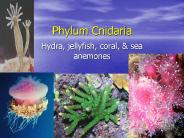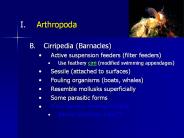Hydrozoan PowerPoint PPT Presentations
All Time
Recommended
jellyfishes, corals, sea anemones, and hydras. worldwide ... hydrozoan colony. Different functions for. different individuals. Class Hydrozoa. Class Anthozoa ...
| PowerPoint PPT presentation | free to view
Water flowing through sponges provides food and oxygen, as ... 1. Hydrozoans-- (Hydra, Portuguese man-of-war, Obelia) Polyp form. Mostly asexual reproduction ...
| PowerPoint PPT presentation | free to view
There are about 35 phyla (this number depends on the systematic system that is used) ... colonial hydroids or hydrozoans are infamous for their very painful, powerful ...
| PowerPoint PPT presentation | free to view
Introduction to Cnidaria Jellyfish, corals, and other stingers. . . Cnidarians are incredibly diverse in form Yet, these diverse animals are all armed with stinging ...
| PowerPoint PPT presentation | free to download
Chapter 7: CNIDARIANS: Jellies, Corals, and Anemones Coral Reefs * * Cnidarians Cnidarians are named because of the stinging cells they possess - cnidocytes ...
| PowerPoint PPT presentation | free to download
Title: Invertebrates Author: owner Last modified by: Amanda Pittman Created Date: 1/26/2006 5:37:29 PM Document presentation format: On-screen Show (4:3)
| PowerPoint PPT presentation | free to download
Porifera: Very Simple Animals...(?) Water in, water out Sponges bring water in through their pores and move it out through the large top opening.
| PowerPoint PPT presentation | free to view
Cnidarians Jellyfish, Hydra, Corals, Sea Anemones, Sea Fans and Sea Pens Cnidarians Soft-bodied animals Stinging tentacles Sac Body Plan Tissue Level of Organization ...
| PowerPoint PPT presentation | free to view
Phylum Cnidaria Cnidarian Taxonomy Phylum Cnidaria Cnidarian Taxonomy General Characteristics They are radially symmetrical; oral end terminates in a mouth ...
| PowerPoint PPT presentation | free to download
The Lophophorates Phylum Brachiopoda Phylum Bryozoa * The Lophophorates The Lophophorates * Lophophorates All are sessile or sedentary adults that feed by means of ...
| PowerPoint PPT presentation | free to view
Kingdom Animalia Invertebrates Phylum Porifera Phylum Cnideria SPONGES Sponges Phylum Porifera (pore-bearers)/ simplest animal Body Symmetry/Shape: Asymmetrical ...
| PowerPoint PPT presentation | free to download
| PowerPoint PPT presentation | free to download
Phylum Cnidaria Basic Info. Marine invertebrates: nearly 9000 species Made up of jellyfish, corals, sea anemones, and hydras. Found everywhere in water Prefer warmer ...
| PowerPoint PPT presentation | free to view
... (polyp & medusa) Blind sack gut Radial symmetry Diploblastic Hydrostatic skeleton Nerve net Many colonial, some solitary forms polyps and medusa stage, ...
| PowerPoint PPT presentation | free to view
chapter 33 invertebrates
| PowerPoint PPT presentation | free to view
Velella velella - by the wind sailor. Fire coral. hydrocoral. Physalia - Portugese man of war ... Aurelia - moon jelly. Pelagia ~Class cubozoa - box jellies ...
| PowerPoint PPT presentation | free to download
The Characteristics of Phylum Cnidaria Phylum Cnidaria Characteristics of Phylum Cnidaria radial symmetry blind sac gut (= coelenteron or gastrovascular cavity ...
| PowerPoint PPT presentation | free to view
Lecture Exam I Cambrian radiation / phylogeny = 2 papers Systematics intro Protista: 10 phyla Animalia: Porifera, Cnidaria ~20 questions Short answer, essay, life ...
| PowerPoint PPT presentation | free to view
Cnidarians Jellyfish, Hydra, Corals, Sea Anemones, Sea Fans and Sea Pens Cnidarians Soft-bodied animals Stinging tentacles Sac Body Plan Tissue Level of Organization ...
| PowerPoint PPT presentation | free to view
... a harpoon or nematocyst shoots out & injects poison into the prey Cnidocyte (stinging cell) Nematocyst (harpoon) Capturing Prey: Cnidocyte and Nematocyst at ...
| PowerPoint PPT presentation | free to view
chapter 7 radiate animals cnidarians and ctenophores 7-*
| PowerPoint PPT presentation | free to download
Tree of Life The tree of life according to Ernst Haeckel, 1891 How does Porifera fit in? How does Cnidaria fit in? Phylum Cnidaria Level of Organization Tissue Layers ...
| PowerPoint PPT presentation | free to download
Phylum Cnidaria Hydra, jellyfish, coral, & sea anemones
| PowerPoint PPT presentation | free to download
Title: PowerPoint Presentation Last modified by: Guardians Created Date: 1/1/1601 12:00:00 AM Document presentation format: On-screen Show (4:3) Other titles
| PowerPoint PPT presentation | free to view
Title: PowerPoint Presentation Author: del Nagle Last modified by: Coach Created Date: 1/1/1601 12:00:00 AM Document presentation format: On-screen Show
| PowerPoint PPT presentation | free to download
... Cnidaria - jellyfish, corals, anemones and hydra. The Nerve Net of the Hydra. Hydra Feeding Behavior. Hydra Feeding Behavior. Hydra Feeding ...
| PowerPoint PPT presentation | free to view
The Invasive and Nonindigenous Fauna of Coastal South Carolina David Knott SouthEastern Regional Tax
| PowerPoint PPT presentation | free to view
Animals: The Invertebrates Chapter 25
| PowerPoint PPT presentation | free to download
CHAPTER 14 Animals of the Pelagic Environment
| PowerPoint PPT presentation | free to download
Chapter 33 Invertebrates
| PowerPoint PPT presentation | free to download
Nematocysts: More firearm than syringe? Study sequenced mediterrean jellyfish, Rhopilema nomadica venom. Identifed unique mechanical ...
| PowerPoint PPT presentation | free to download
Porifera (Sponges), Cnidarians (hydra, jellyfish, sea anemone, some corals) Ctenophores ( comb jellies) pictures from: http://www.bio.miami.edu/dana/160/160S06_14 ...
| PowerPoint PPT presentation | free to download
3. Annelid - leech 4. roundworm - Ascaris. Name that worm.... 3. 4. ... Setae annelid (bristleworm) 2. Scolex flatworm (tapeworm) 3. Proglottids - flatworm ...
| PowerPoint PPT presentation | free to view
Title: PowerPoint Presentation Author: GES GES Last modified by: Coast Tsimshian Academy Created Date: 11/5/2002 12:14:22 AM Document presentation format
| PowerPoint PPT presentation | free to download
ANIMAL KINGDOM - THE INVERTEBRATES E. PHYLUM ANNELIDA Segmented Worms F. PHYLUM MOLLUSCA Soft Body G. PHYLUM ARTHROPODA Jointed foot H. PHYLUM ...
| PowerPoint PPT presentation | free to view
Arthropoda Cirripedia (Barnacles) Active suspension feeders (filter feeders) Use feathery cirri (modified swimming appendages) Sessile (attached to surfaces)
| PowerPoint PPT presentation | free to download
Title: PowerPoint Presentation Author: Stacy - McGraw-Hill Higher Education Last modified by: CCS Created Date: 11/7/2002 3:12:30 PM Document presentation format
| PowerPoint PPT presentation | free to download
calcium carbonate in ocean. Phylum Cnidaria. Nematocysts (stinging cells) Radial symmetry ... animals that live in the sea? What is an example of a radially-symmetric ...
| PowerPoint PPT presentation | free to download
... fish is also protandry Finding Nemo is wrong! Dad should become Mom! Clown anemonefish & eggs with sea anemone The Other Anthozoan ...
| PowerPoint PPT presentation | free to download
Review of Porifera, cnidarians, and the Worms. Name the group that has: ... Hermaphrodite - all. External Fertilization - all. Nematoda. Annelida. Platyhelminthes ...
| PowerPoint PPT presentation | free to view
The largest jellyfish is the Arctic Giant Jellyfish: it can have a diameter over ... The most venomous jellyfish is the Australian Sea Wasp; death can occur within 1 ...
| PowerPoint PPT presentation | free to view
Each animal phylum has a unique body plan. Vertebrates have an internal segmented backbone. Invertebrates do not have a backbone. Invertebrates encompass most animal ...
| PowerPoint PPT presentation | free to download
Chapter 26: Sponges and Cnidarians 26-1 Introduction to the Animal Kingdom What makes animals different from the previous organisms we have covered so far this year?
| PowerPoint PPT presentation | free to download
Order: Actiniaria (true anemones) Never colonial. No calcareous ... Order: Cerianthara (Tube Anemone) Order: Zoanthidea (stalked anemones) Class: Anthozoa ...
| PowerPoint PPT presentation | free to view
Chapter 25. The Animal Kingdom I: Introducing the Invertebrates. The Diversity of Animals ... Invertebrates that live in freshwater are more likely to have protected ...
| PowerPoint PPT presentation | free to view
Polyp - cup-shaped; mouth & tentacles at one end; sessile (anemones) ... may form a reef or foundation for an island. Sea anemones. polyps that have rows of tentacles ...
| PowerPoint PPT presentation | free to view
... conservation, reproduction, and sound management of biological resources in the shelf zone; the study of adaptations, ontogenesis, ...
| PowerPoint PPT presentation | free to download
Reef builders that have a nasty ... L-form hydroids Feather-shaped colonies Obelia is the most famous ... solitary Responsible for the building of coral ...
| PowerPoint PPT presentation | free to view
Frilled Anemone. General Characteristics. Radially symmetrical invertebrates ... Movements of clownfish prevents sediment from burying the anemone. ...
| PowerPoint PPT presentation | free to view
Chapter 13 Intertidal Communities Key Concepts The intertidal zone is the coastal area alternately exposed and submerged by tides. Organisms that inhabit intertidal ...
| PowerPoint PPT presentation | free to view
AP Biology Exam Review Survey of the Kingdoms
| PowerPoint PPT presentation | free to download
All are multicellular; and undergo ... Most can move; have specialized muscle tissues. ... Others have a bilaterally symmetrical larva called a nauplius. ...
| PowerPoint PPT presentation | free to view
fusion of two haploid gametes (sperm and egg) to form a diploid zygote ... Fission: asexual reproduction of a sea anemone (Anthopleura elegantissima) ...
| PowerPoint PPT presentation | free to view
























































